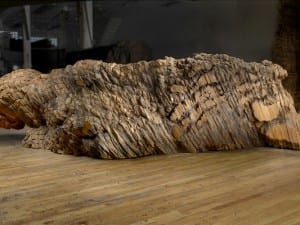Curated by Turner Prize winning artist Jeremy Deller, Love is Enough explores the relationship between two artists whose lives and artistic practices belonged to different centuries, William Morris, (1834-1896) and Andy Warhol (1928-1987). The comparison might be bold, and Deller admits to having taken liberties with two artists who are no longer living, by placing their works side by side: “But having said that, I imagine Warhol would have approved, as he always had a keen sense of art history.” The presence of a third artist is suggested by the exhibition, as indicative of a personal influence, Deller citing both artists as influential on his own work.
Morris is well known for his revolutionary leadership of the Arts and Crafts Movement, which represented the antithesis of rapid industrialisation. It championed nature, romanticism, simplicity and the medieval heritage of Britain. Most remarkably, it elevated craft and design to the realm of art, while simultaneously retaining its democratic spirit. Pop culture then is not so far removed from this ethos; Warhol’s reappropriation of widely circulated and instantly recognisable images and moving them into the museum and art gallery can be seen to reflect Morris’ famous declaration: “I do not want art for a few, any more than I want education for a few or freedom for a few.”
That is not the only basis, however, for combining the two in Love is Enough. The rooms are arranged thematically, drawing comparisons between both artists’ penchant for representing their preferred mythologies, their political and social stances, working practices, various careers, their attention to detail as well as making reference to the re-emergence of the popularity of Pre-Raphaelite art in the sixties through the juxtaposition of both Warhol’s and Morris’ treatment of natural motifs.
Whether the artists being exhibited side by side may prove problematic for some visitors, several of the works featured in the exhibition require no introduction, being either instantly recognisable or remarkably beautiful, their display offers a unique opportunity. Showing the work of two artists from different eras in not a new practice; there was Manet/ Velázquez at the Metropolitan Museum of Art in New York in 2003 and even Turner/ Monet/ Twombly held at Tate Liverpool in 2012.
It is the manner in which the exhibition itself and the featuring of both Morris and Co. and Warhol wallpaper which draw up a different commentary, that of modern exhibition strategy. Since J. M. Whistler first introduced the notion that would become the white cube in his Arrangement in White and Yellow, which debuted at the Fine Art Society in 1883, modernism became associated with a clean, white, sterile aesthetic through which to exhibit art; a revolution in light of the Academic practice of stacking paintings frame to frame. This has been the method for galleries and museums to show art ever since; to exhibit differently is to appear old-fashioned.
Love is Enough on the other hand, attempts what could be dubbed a Gesamtkunstwerk method of exhibiting. More commonly associated with the art of Vienna at the turn of the 20th century, the Vienna Secession’s debut exhibition featuring both art works and interior design to create the sensation of being immersed in art, in order to bring art and life closer together is echoed here. Just as Morris once said: “Decoration is futile, when it does not remind you of something that is beyond itself.” This edict is echoed spectacularly in Morris’ illustrated Collected Works of Geoffrey Chaucer currently on display in the gallery, combining his designs, his entrepreneurship in establishing the Kelmscott Press and his love of folklore with the immortal poetry of England’s preeminent medieval bard.
The exhibition’s title, taken from one of Morris’ own writings exemplifying the importance of love over wealth imbue the exhibition with a moral and political diatribe. It is possible that Deller is attempting to revive the practice of viewing exhibitions as a whole, rather than simply as a conduit for the display and appreciation of individual art works, and even if unsuccessful, has succeeded in prompting a commentary about the art of displaying art amongst his audience.
Andy Warhol and William Morris: Love is Enough, until 8 March, Modern Art Oxford.
Laura Catsellis
Credits
1. Andy Warhol, “Andy Warhol holding the Marilyn acetate used to make his famous 40” paintings, known as the Shot Marilyns, at the doorway of the fire escape at the Factory on East 47th Street.” , photographic print, 1964 © William John Kennedy; Courtesy of KIWI Arts Group and DACS, London.




